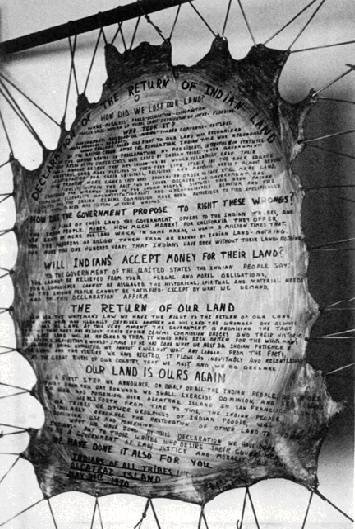ALCATRAZ Proclamation: Difference between revisions
No edit summary |
(added abstract) |
||
| (7 intermediate revisions by 2 users not shown) | |||
| Line 1: | Line 1: | ||
'''<font face = Papyrus> <font color = maroon> <font size = 4>Primary Source</font></font> </font>''' | |||
[[Image:nativam$alcatraz-proclamation-photo.jpg]] | [[Image:nativam$alcatraz-proclamation-photo.jpg]] | ||
| Line 5: | Line 7: | ||
''Photo: Ilka Hartmann'' | ''Photo: Ilka Hartmann'' | ||
'''The proclamation of the Indians of All Tribes who | [[Image:Addressing-injustice.png|left]] | ||
{| style="color: black; background-color: #F5DA81;" | |||
| colspan="2" | '''Using language developed during the Indian Tribes' occupation of Alcatraz from November 1969 to June 1971, the Alcatraz Proclamation addresses the US government—and more broadly the history of white settlers—with demands based on historical precedents and to call attention to the conditions Indians live in.''' | |||
|} | |||
'''The proclamation of the Indians of All Tribes who [[The Indian Occupation of ALCATRAZ|occupied Alcatraz]] from November 1969 to June 1971:''' | |||
'''To the Great White Father and All His People:''' | '''To the Great White Father and All His People:''' | ||
| Line 35: | Line 50: | ||
''--from ALCATRAZ! ALCATRAZ!'' ''by Adam Fortunate Eagle, [http://www.heydaybooks.com Heyday Books]: Berkeley, CA Copyright 1992 by the author. | ''--from ALCATRAZ! ALCATRAZ!'' ''by Adam Fortunate Eagle, [http://www.heydaybooks.com Heyday Books]: Berkeley, CA Copyright 1992 by the author. | ||
[[The Indian Occupation of ALCATRAZ |Prev. Document]] [[ | [[The Indian Occupation of ALCATRAZ |Prev. Document]] [[Reflections from Occupied Ohlone Territory |Next Document]] | ||
[[category:Indigenous]] [[category:1960s]] [[category:1970s]] [[category:Dissent]] | [[category:Indigenous]] [[category:1960s]] [[category:1970s]] [[category:Dissent]] [[category:Bay Area Social Movements]] | ||
Latest revision as of 20:18, 29 March 2015
Primary Source
Alcatraz Proclamation
Photo: Ilka Hartmann
| Using language developed during the Indian Tribes' occupation of Alcatraz from November 1969 to June 1971, the Alcatraz Proclamation addresses the US government—and more broadly the history of white settlers—with demands based on historical precedents and to call attention to the conditions Indians live in. |
The proclamation of the Indians of All Tribes who occupied Alcatraz from November 1969 to June 1971:
To the Great White Father and All His People:
We, the native Americans, re-claim the land known as Alcatraz Island in the name of all American Indians by right of discovery. We wish to be fair and honorable in our dealings with the Caucasian inhabitants of this land, and hereby offer the following treaty: We will purchase said Alcatraz Island for 24 dollars in glass beads and red cloth, a precedent set by the white man's purchase of a similar island about 300 years ago. We know that $24 in trade goods for these sixteen acres is more than was paid when Manhattan Island was sold, but we know that land values have risen over the years. Our offer of $1.24 per acre is greater than the 47 cents per acre the white men are now paying the California Indians for their land. We will give to the inhabitants of this land a portion of that land for their own, to be held in trust by the American Indian Government for as long as the sun shall rise and the rivers go down to the sea -- to be administered by the Bureau of Caucasian Affairs (BCA). We will further guide the inhabitants in the proper way of living. We will offer them our religion, our education, our life-ways, in order to help them achieve our level of civilization and thus raise them and all their white brothers up from their savage and unhappy state. We offer this treaty in good faith and wish to be fair and honorable in our dealings with all white men.
We feel that this so-called Alcatraz Island is more than suitable as an Indian Reservation, as determined by the white man's own standards. By this we mean that this place resembles most Indian reservations, in that:
1. It is isolated from modern facilities, and without adequate means of transportation.
2. It has no fresh running water.
3. The sanitation facilities are inadequate.
4. There are no oil or mineral rights.
5. There is no industry and so unemployment is very great.
6. There are no health care facilities.
7. The soil is rocky and non-productive and the land does not support game.
8. There are no educational facilities.
9. The population has always been held as prisoners and kept dependent upon others.
Further, it would be fitting and symbolic that ships from all over the world, entering the Golden Gate, would first see Indian land, and thus be reminded of the true history of this nation. This tiny island would be a symbol of the great lands once ruled by free and noble Indians.
--from ALCATRAZ! ALCATRAZ! by Adam Fortunate Eagle, Heyday Books: Berkeley, CA Copyright 1992 by the author.


